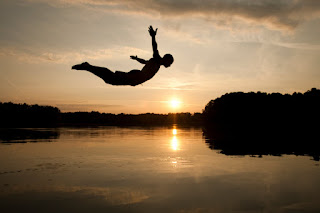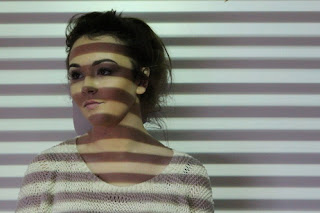Please view this film as a model for what we're about to do.
We are going to practice film making by doing the following project:

 Most people are at least somewhat familiar with the rule of thirds. The rule of thirds is utterly ubiquitous: Every movie and TV show makes almost constant use of it, and professional photographers avoid putting the subject in the center of the frame almost without exception. To understand it, draw two lines through a photo, dividing it into thirds. This turns it into something like a tic-tac-toe board, as you see here.
Most people are at least somewhat familiar with the rule of thirds. The rule of thirds is utterly ubiquitous: Every movie and TV show makes almost constant use of it, and professional photographers avoid putting the subject in the center of the frame almost without exception. To understand it, draw two lines through a photo, dividing it into thirds. This turns it into something like a tic-tac-toe board, as you see here.

 At its essence, the rule of thirds says that you'll get the most interesting photos when your subject isn't in the center of the frame, but rather is positioned off-center, to the left, right, up, or down. You can position your subject at any of the four intersection points of the third lines, or along one of the four lines, like the birds in this example.
At its essence, the rule of thirds says that you'll get the most interesting photos when your subject isn't in the center of the frame, but rather is positioned off-center, to the left, right, up, or down. You can position your subject at any of the four intersection points of the third lines, or along one of the four lines, like the birds in this example.

 Here's another trick using lines: If you want to add a sense of drama to your photograph, look for ways to incorporate a diagonal. Draw a mental line from one corner of the scene to the other; if you can find some element in the situation that more or less follows this line, it can make your shot more dynamic and add some energy to the scene, almost as if it's pulling the viewer through the scene. The diagonal can run the entire length of the photo, as it does in this photo.
Here's another trick using lines: If you want to add a sense of drama to your photograph, look for ways to incorporate a diagonal. Draw a mental line from one corner of the scene to the other; if you can find some element in the situation that more or less follows this line, it can make your shot more dynamic and add some energy to the scene, almost as if it's pulling the viewer through the scene. The diagonal can run the entire length of the photo, as it does in this photo.

 But it's not critical for your diagonal to span the entire photo. You can get essentially the same effect even with a partial diagonal, such as this.
But it's not critical for your diagonal to span the entire photo. You can get essentially the same effect even with a partial diagonal, such as this.

 This is a fun one. No doubt you've seen photos in which most of the frame is filled with more or less the same thing: a field of grass, a pile of pennies, rocks, fish, stars in the night sky. Such photos truly would be monotonous if that's all they offered, but often, the photographer will incorporate one out-of-place element that attracts your eye like a magnet. With that in mind, this rule says that you should look for photos that are mostly uniform and then break the pattern with an element that disturbs the natural flow or organization of the scene.
This is a fun one. No doubt you've seen photos in which most of the frame is filled with more or less the same thing: a field of grass, a pile of pennies, rocks, fish, stars in the night sky. Such photos truly would be monotonous if that's all they offered, but often, the photographer will incorporate one out-of-place element that attracts your eye like a magnet. With that in mind, this rule says that you should look for photos that are mostly uniform and then break the pattern with an element that disturbs the natural flow or organization of the scene.

 Even better, though, is when you incorporate a lesson from the rule about monotonous content and shake things up with a little variation. Surprise the viewer, either by making one side of the photo non-symmetrical, or, in this example, defeat the symmetry of the flower by shooting only part of it in the frame.
Even better, though, is when you incorporate a lesson from the rule about monotonous content and shake things up with a little variation. Surprise the viewer, either by making one side of the photo non-symmetrical, or, in this example, defeat the symmetry of the flower by shooting only part of it in the frame.

 One of my favorite photo subjects is motion. I like capturing the essence of speed and energy in what's by its very definition a static art form. But how you introduce that motion into your photo is really important. Whether you're shooting a speeding car, an airplane, a flock of birds, or a running dog, be sure that the motion leads into the frame, not out of it. By that, I mean you should give the leading edge of your moving subject plenty of room; it should be positioned on a third line (see the rule of thirds) and pointed at the center of the frame, not at the closest edge, as you see in this shot.
One of my favorite photo subjects is motion. I like capturing the essence of speed and energy in what's by its very definition a static art form. But how you introduce that motion into your photo is really important. Whether you're shooting a speeding car, an airplane, a flock of birds, or a running dog, be sure that the motion leads into the frame, not out of it. By that, I mean you should give the leading edge of your moving subject plenty of room; it should be positioned on a third line (see the rule of thirds) and pointed at the center of the frame, not at the closest edge, as you see in this shot.
HORIZON LINES
We are going to practice film making by doing the following project:
- In your group* (see below) use the cameras available to take example shots. You can use your creativity, but only take 10 minutes (I'll time you) to shoot your camera/angle/shot examples. You do not need a coherent story--just the example shots. Students in your group should share the responsibility of being in the shot or taking the shot.
- You will then edit these shots together using a film editing program and submit them for our viewing
- Use Windows Moviemaker (or Premiere) to arrange your shot/angle examples (all students should learn how to use the program. If you are already familiar with how to edit, allow your peers (who don't have as much experience) edit--you should be available to them to help guide them.
- In your film, please include a title screen with your group's names
- Identify and number each shot (Include a TITLE for each shot naming that shot). You can, of course, also announce the shot by your voice over, but it should be clear what the shot is.
- After you create and edit your film, please upload it to Youtube and send me the link for the film in the COMMENT section below. We will screen these projects next class.
Groups:
Group A: Kordae, Victoria, Joshua
Extreme close up, close up, medium shot, long shot, extreme long shot
Group B: Akhiyar, Raeona, Javant, Alquasia
Low angle, oblique (Dutch) angle, High angle, pan, tilt
Group C: Kemani, Isobel, Turon, Jesziah
Tracking shot, deep focus shot, cut, dissolve, fade out
Group D: Jenna, Pahz, Ja'Miah, Britney
Establishing shot, shot/reverse shot, eyeline match, wipe, zoom
While you are waiting for a camera to shoot your "film" footage, please work on the following:
NOTE the following information. Learn it. Use it for the next project.
The Rules of Photographic Composition
Take Better Photos With Your Digital Camera:
Follow the Rule of Thirds
Use Diagonals to Your Advantage
Break the Monotony
Make it Symmetric (and Then Disturb Your Symmetry)
Rules, of course, are meant to be broken. The rule of symmetry is all about capturing the natural symmetry in nature. There are a few ways to do this. You might shoot a scene in which both sides of your photo are essentially the same, for example. Or you might shoot a photo of something that is itself quite symmetrical, like a flower.
Position Movement Into the Frame
HORIZON LINES
A good technique for landscape shots is to position horizons or building (objects) along one of the horizontal lines.

Dividing a composition in half by placing the horizon across the middle of the frame can create a powerful composition with the right subject and appropriate light. See below.

Horizons placed very low in the frame heighten the isolation of subjects at the horizon.


Isolating one person at the bottom (or top) edge of the frame can create an atmosphere of emptiness by contrasting it with the vastness of the sky, or to suggest ascension or flight.

You can also apply the rule of thirds guidelines to the placement of the horizon in your photos. Here the center position of the boat and horizon results in a static feeling. We've moved the horizon line to the lower third. In general, place the horizon high or low in your scenes, but rarely in the middle. Centered shots may suggest order or symmetrical balance. Taking a shot head on is also awkward. Avoid this kind of shot when making documentaries. The position of the subject shot off-center, suggests conflict.



For more examples and advice, check out this link!
TASK TWO: Biography Photo Series
Take a look at these example Biography Photo Series.
Step 1: Choose a subject for a photo series. This should be someone you can follow around or someone who you have some normal contact with. It can be a friend, a relative, a community member, or even yourself (selfies!), etc.
Step 2: With your cell phone or a camera, shoot 5 photos that you will arrange to communicate some artistic message to the world. See and use the Photo Analysis assignment notes above for assistance.
Step 3: Arrange your photos for class viewing. This could be a Prezi, a Google Presentation, or a Padlet.
Step 4: Give your photo sequence a title.
Step 5: Write a brief 100-300 word explanation of your series. What are you attempting to show and/or comment on through your photography? Most photographic series have a point or comment about society, the subject, or humanity in general. What's your theme or message? Explain it.
When you snap a picture, remember to consider the rule of thirds!

Dividing a composition in half by placing the horizon across the middle of the frame can create a powerful composition with the right subject and appropriate light. See below.

Horizons placed very low in the frame heighten the isolation of subjects at the horizon.


Isolating one person at the bottom (or top) edge of the frame can create an atmosphere of emptiness by contrasting it with the vastness of the sky, or to suggest ascension or flight.

You can also apply the rule of thirds guidelines to the placement of the horizon in your photos. Here the center position of the boat and horizon results in a static feeling. We've moved the horizon line to the lower third. In general, place the horizon high or low in your scenes, but rarely in the middle. Centered shots may suggest order or symmetrical balance. Taking a shot head on is also awkward. Avoid this kind of shot when making documentaries. The position of the subject shot off-center, suggests conflict.



For more examples and advice, check out this link!
TASK TWO: Biography Photo Series
Take a look at these example Biography Photo Series.
Step 1: Choose a subject for a photo series. This should be someone you can follow around or someone who you have some normal contact with. It can be a friend, a relative, a community member, or even yourself (selfies!), etc.
Step 2: With your cell phone or a camera, shoot 5 photos that you will arrange to communicate some artistic message to the world. See and use the Photo Analysis assignment notes above for assistance.
Step 3: Arrange your photos for class viewing. This could be a Prezi, a Google Presentation, or a Padlet.
Step 4: Give your photo sequence a title.
Step 5: Write a brief 100-300 word explanation of your series. What are you attempting to show and/or comment on through your photography? Most photographic series have a point or comment about society, the subject, or humanity in general. What's your theme or message? Explain it.
When you snap a picture, remember to consider the rule of thirds!
This project is NOT due yet, (see homework)
If you cannot proceed with your photography project, or you are done with your film project and are fooling around, instead, please view the following camera technique videos:
HOMEWORK: Please shoot 5 photos (or select 5 photos from the thousands you might have taken for this project). Use what you have learned in film as well as the advice about taking better photos from today's lesson.
Bring your photos/files to Thursday's class. You will have time in the lab to arrange and prepare your biography photo series.
If you did not view the linked videos, please watch them and learn how to be a better cinematographer.



No comments:
Post a Comment